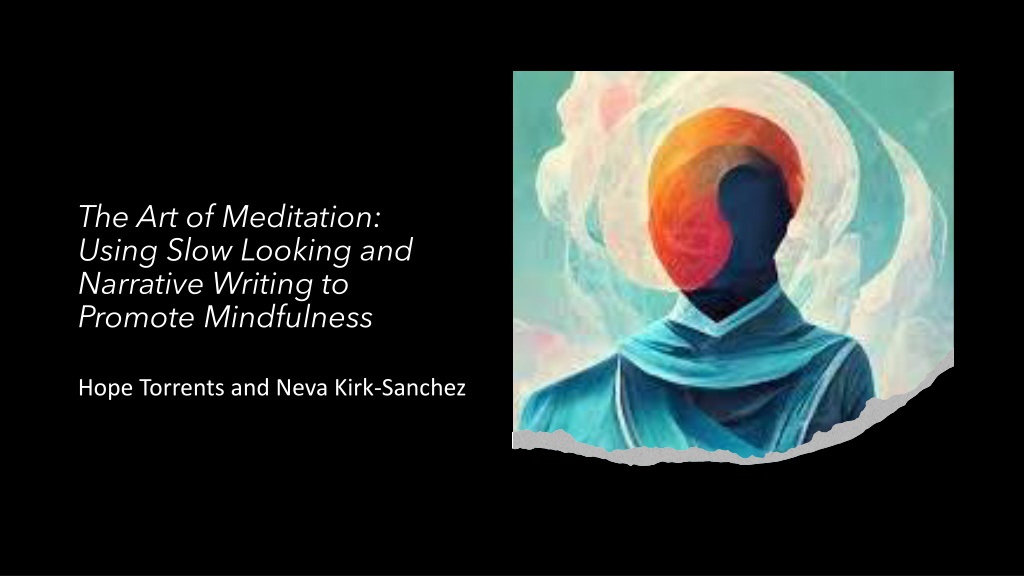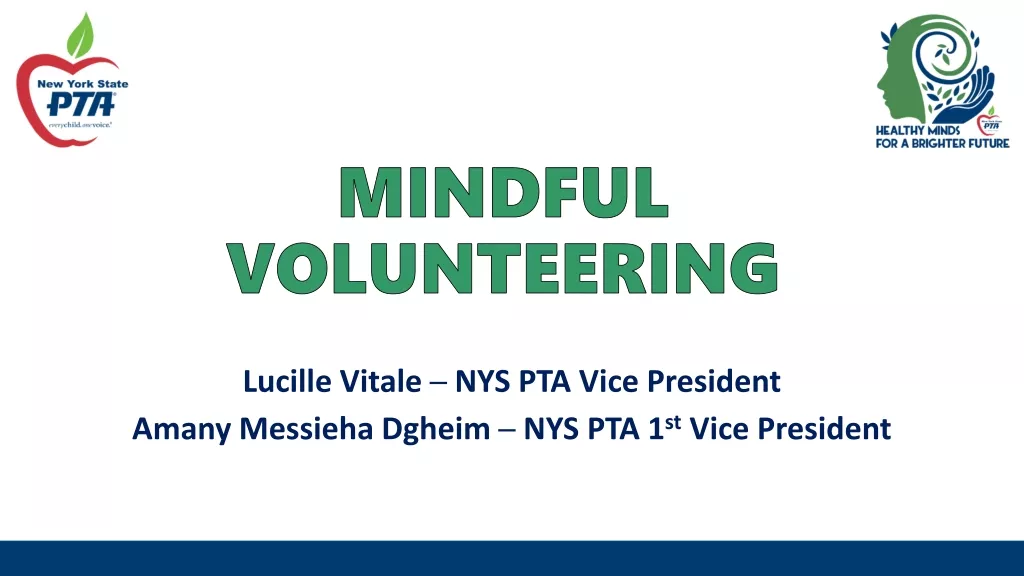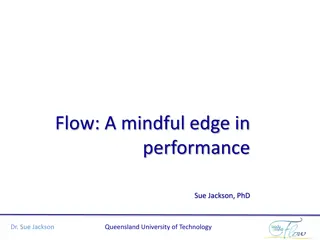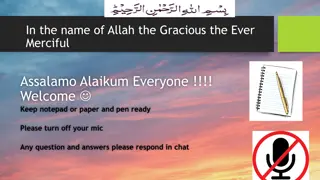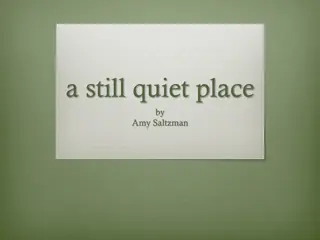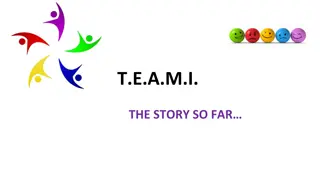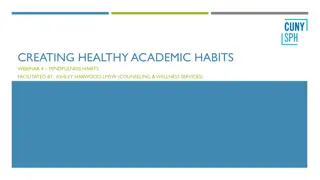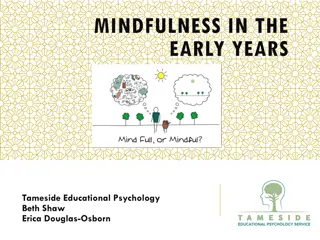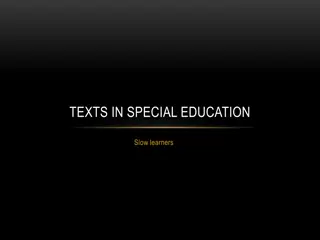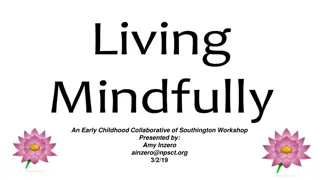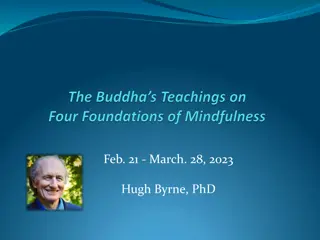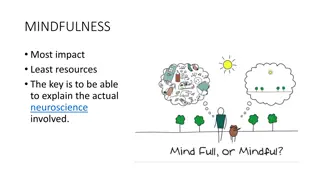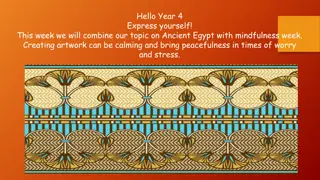Exploring the Art of Slow Looking and Narrative Writing for Mindfulness
Delve into the transformative practice of slow looking and narrative writing as mindfulness techniques, supported by literature for enhancing psychological well-being. Learn to incorporate these strategies into various professions and educational settings, fostering self-reflection, focus, and compassion.
Download Presentation

Please find below an Image/Link to download the presentation.
The content on the website is provided AS IS for your information and personal use only. It may not be sold, licensed, or shared on other websites without obtaining consent from the author. Download presentation by click this link. If you encounter any issues during the download, it is possible that the publisher has removed the file from their server.
E N D
Presentation Transcript
The Art of Meditation: Using Slow Looking and Narrative Writing to Promote Mindfulness Hope Torrents and Neva Kirk-Sanchez
Participants will be able to: Describe the literature supporting slow looking and narrative writing as mindfulness techniques that improve psychological well-being across a wide variety of professions Develop these mindfulness strategies into their own mindfulness programs Incorporate mindful looking and narrative writing into higher educational programs Workshop Objectives
What is Mindfulness? Mindfulness is present-moment, non-judgmental awareness Aspirations for practice: To practice mindfulness using a work of art as the object of our attention To investigate mind-body awareness To cultivate focus and concentration To be aware of emotions, both pleasant and non-pleasant as they arise in the present moment To cultivate kindness, gratitude and compassion To reflect on the process, together, in a virtual community What is your intention for today s practice?
Evidence for mindfulness in health professionals Mindfulness is a process of intentional paying attention to experiencing the present moment with curiosity, openness and acceptance of each experience without judgment. Mindfulness practice improves psychological well-being in health professionals. Significant reductions in burnout, stress, anxiety, and depression Improvement in self-compassion, resilience, and psychological well- being Better ability to respond to stimuli effectively Kriakous et al 2020, Chmielewski, 2019
Slow looking is one practice of mindfulness defined as the practice of observing detail over time to move beyond a first impression and create a more immersive experience with a text, an idea, a piece of art, or any other kind of object. Tishman, 2017
Pedagogy of slow Facilitates transformation learning Fosters self-reflection Supple, Briony, and James G. R. Cronin. 2023. A Pedagogy of Slow: Integrating Experiences of Physical and Virtual Gallery Spaces to Foster Critical Engagement in SoTL. Teaching & Learning Inquiry 11. https://doi.org/10.20343/teachlearninqu.11.2
Reflection First Noticing Then Processing
Reflection Questions What did you observe during today s practice? For example: were you aware of sensations in your body? (e.g., tension in the shoulders, eyes, jaw, breathing; temperature of the air on the skin) were you aware of feelings/emotions (e.g., serenity, anxiety, frustration, boredom, sadness, fear, hope) When your mind wandered, were you aware of where it wandered? Anything else?
Andrew Wyeth, 1917-2009 That Gentlemen, 1960, Andrew Wyeth, tempera on board, Dallas Museum of Art man named Tom Clark, who was the neighbor of Mr. Wyeth. . Mr. Wyeth wrote about Mr. Clark, stating: His voice is gentle, his wit is keen, and his wisdom enormous. That Gentlemen portrays an elderly African-American was an American visual artist, primarily a realist painter, working predominantly in a regionalist style. He was one of the best-known U.S. artists of the middle 20th century. In his art, Wyeth's favorite subjects were the land and people around him, both in his hometown of Chadds Ford, Pennsylvania, and at his summer home in Cushing, Maine. Wyeth often said: "I paint my life." One of the best-known images in 20th-century American art is his tempera painting Christina s World , currently in the collection of the Museum of Modern Art in New York City, which was painted in 1948, when Wyeth was 31 years old. Andrew Newell Wyeth July 12, 1917 January 16, 2009)
Andrew Wyeth, who has died aged 91, was America's best-known painter. Even his models became famous just for being his models: one was the subject of a biography, another, his neighbour Helga, was the centre of scandalised speculation because the series of nudes for which she posed seemed so unduly intimate. John Updike, a good judge in these matters, wrote with sly lubriciousness when the paintings of Helga were first shown: "tangled pubic hair... confronts us - affronts us, even - as if still wet from the artist's brush." But Wyeth was loved by the public for much the same reasons that the rural poet Robert Frost had been, and their careers described a similar trajectory. Both lived to be very old; both were taken up by President Kennedy's administration (Frost read a poem at the Kennedy inauguration in 1961, and Wyeth was awarded the Presidential Medal for Freedom); both won Pulitzer prizes; both were thought, like the movie director John Ford, to encapsulate in their work the essence of old frontier values. Shaker simplicity might describe his technique as well: his main medium was tempera, which has egg yolk as an emulsifying agent. It was widely used in the early Renaissance before the brilliance of oils took over, and helps to impart a sense of clarity and simplicity to colour fields. "Tempera is something with which I build," he said, "like building in great layers, the way the earth was itself built."
Narrative writing Narrative writing enhances the sense of story Story form , both oral and written, is a fundamental linguistic, psychological, cultural,and philosophical framework to come to terms with the nature and condition of our (or the patient s) existence. Related to reflection expertise- enhancing metacognitive implied process where by personal experience informs practice
Narrative writing process Reflection is a skill that progresses linearly in time Reflection occurs through psychological operations applied to life experiences Writing is a method used to display and measure the quality of reflection Written texts allow readers access to writers' thoughts , motives, and feeling
Writing enhances ability to find the story in observations or events Does not have to be a clinical prompt to help build story-finding skills Learners learn to read or look while practicing writing Writing for medical training Building skills in representing complex situations and receiving and decoding the utterances of others better equips learners for clinical care.
What feelings are engendered when you see this piece? Please write a short response.
